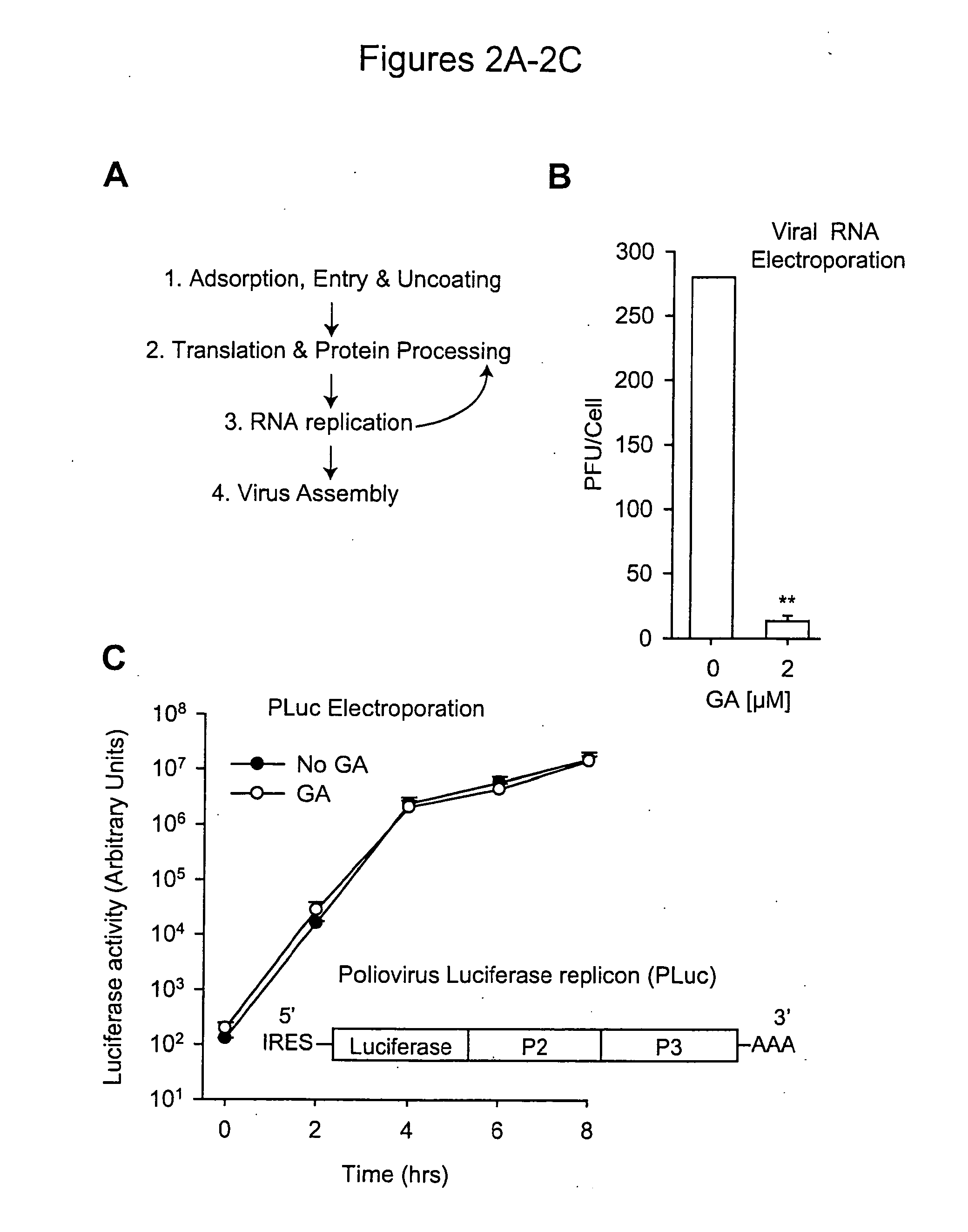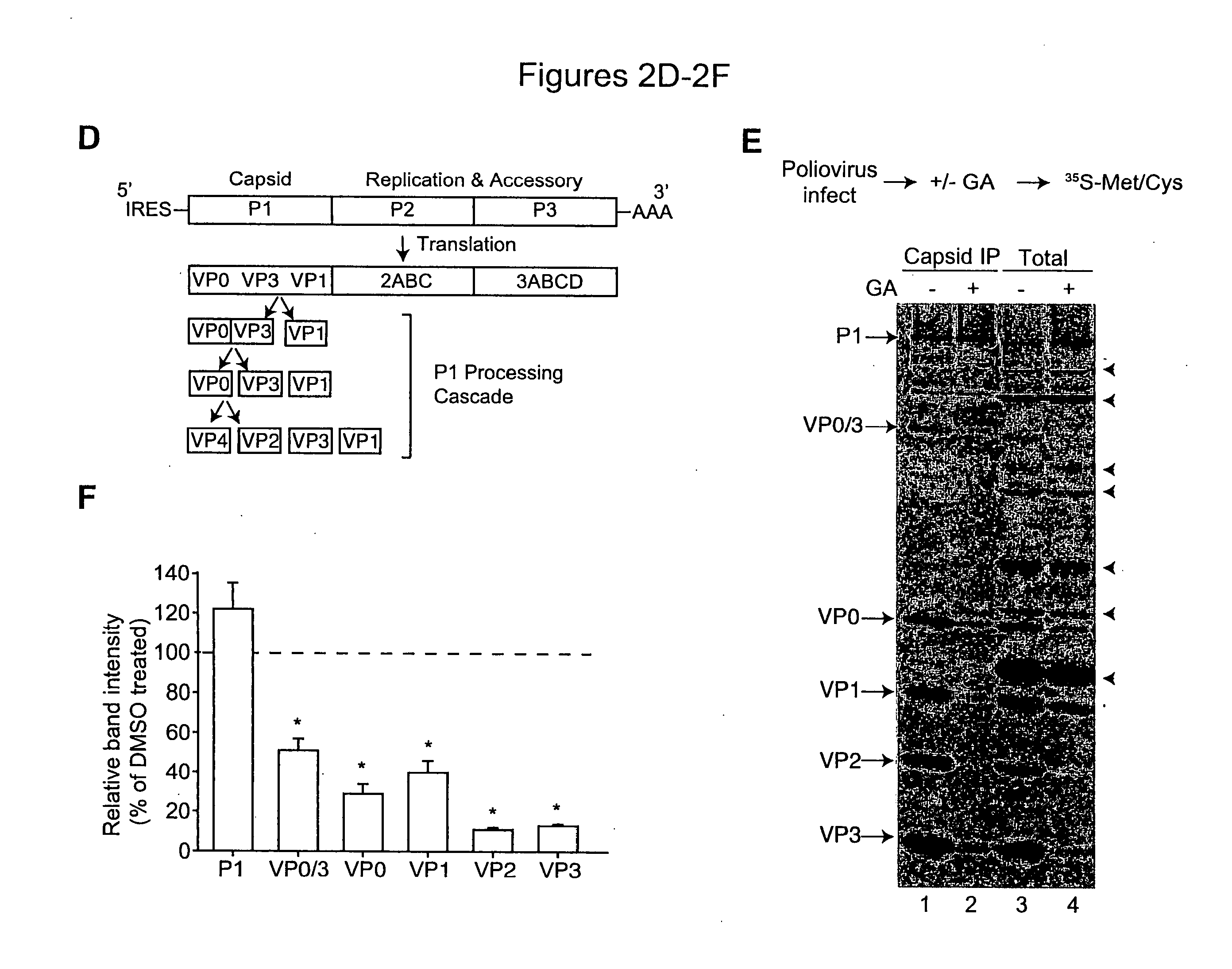Methods of treating viral infection
a viral infection and treatment method technology, applied in the field of viral infection treatment methods, can solve the problems of viral drug resistance emergence and drug resistance, and achieve the effect of reducing the activity of a host cell protein
- Summary
- Abstract
- Description
- Claims
- Application Information
AI Technical Summary
Benefits of technology
Problems solved by technology
Method used
Image
Examples
example 1
Inhibition of Picornavirus
[0146]Hsp90 inhibitors impaired the replication of three major picornavirus pathogens in tissue culture: poliovirus, the agent of poliomyelitis; rhinovirus, the agent of the common cold; and coxsackievirus. Strikingly, poliovirus was unable to develop escape mutants resistant to an Hsp90 inhibitor, even though its rapid replication rate and high mutation frequency (106 times higher than that of DNA based genomes) enabled the isolation of drug resistant poliovirus variants to virtually all other antiviral compounds tested to date. These results suggest that stringent constraints prevent proteins from being able to evolve folding pathways that bypass their Hsp90 requirement. Importantly, this finding uncovered a target for antiviral therapies which may be refractory to development of drug resistance in vivo. Indeed, it was found that administration of Hsp90 inhibitors to infected animals drastically reduced poliovirus replication without eliciting viral drug ...
example 2
Hsp90 Inhibitors as Antiviral Agents for the Treatment of Flavivirus Infection
[0179]Part 1. Reduction of Viral Replication in Cultured Cells:
[0180]Flaviviruses (Includes Hepatitis C Virus, West Nile Virus, Yellow Fever Virus, Dengue Virus):
[0181]Standard cultured cells (e.g., Vero or BHK 21) are infected with yellow fever vaccine strain 17D or a laboratory strain of Dengue virus at a multiplicity of infection of 1-5. Hsp90 inhibitors (such as geldanamycin or its derivative 17-AAG) are added post infection. Effects on viral replication are measured at different times after infection, including 24 and 48 hours. Virus production in tissue culture supernatant is measured by standard protocol of plaque assay or 50% tissue culture infective dose tissue culture cells (ie BHK-21). Reduced virus production in the presence of Hsp90 inhibitors is indicative of an antiviral effect mediated by Hsp90 inhibition.
[0182]Part 2: Reduction of Viral Replication In Vivo
[0183]For any virus family from pa...
example 3
Hsp90 Inhibitors as Antiviral Agents for the Treatment of Influenza Virus Infection
[0193]Part 1: Inhibition of Viral Replication In Vitro
[0194]Experiments are carried out in a manner similar to those described in Example 2, using standard cultured cells (e.g., MDCK). The influenza A strain WSN / 33 is used. Additionally, virus production is measured at earlier time points (e.g., 8, 12, 24 hours).
[0195]Part 2: Inhibition of Viral Replication In Vivo
[0196]Where an in vitro antiviral effect is observed in Part 1, an animal model for one virus member of the family is tested for antiviral effects in vivo, e.g., in an animal model of influenza virus infection.
[0197]Influenza Model:
[0198]The influenza A virus WSN / 33 or another influenza virus is used to infect mice (C57BL / 6 or Balb / C) intranasally. Mice are treated with Hsp90 inhibitors intraperitoneally the day of infection and on subsequent days after infection. Between days 3-5 post-infection, the lungs are removed and the viral load exam...
PUM
| Property | Measurement | Unit |
|---|---|---|
| Time | aaaaa | aaaaa |
| Time | aaaaa | aaaaa |
| Electrical resistance | aaaaa | aaaaa |
Abstract
Description
Claims
Application Information
 Login to View More
Login to View More - R&D
- Intellectual Property
- Life Sciences
- Materials
- Tech Scout
- Unparalleled Data Quality
- Higher Quality Content
- 60% Fewer Hallucinations
Browse by: Latest US Patents, China's latest patents, Technical Efficacy Thesaurus, Application Domain, Technology Topic, Popular Technical Reports.
© 2025 PatSnap. All rights reserved.Legal|Privacy policy|Modern Slavery Act Transparency Statement|Sitemap|About US| Contact US: help@patsnap.com



